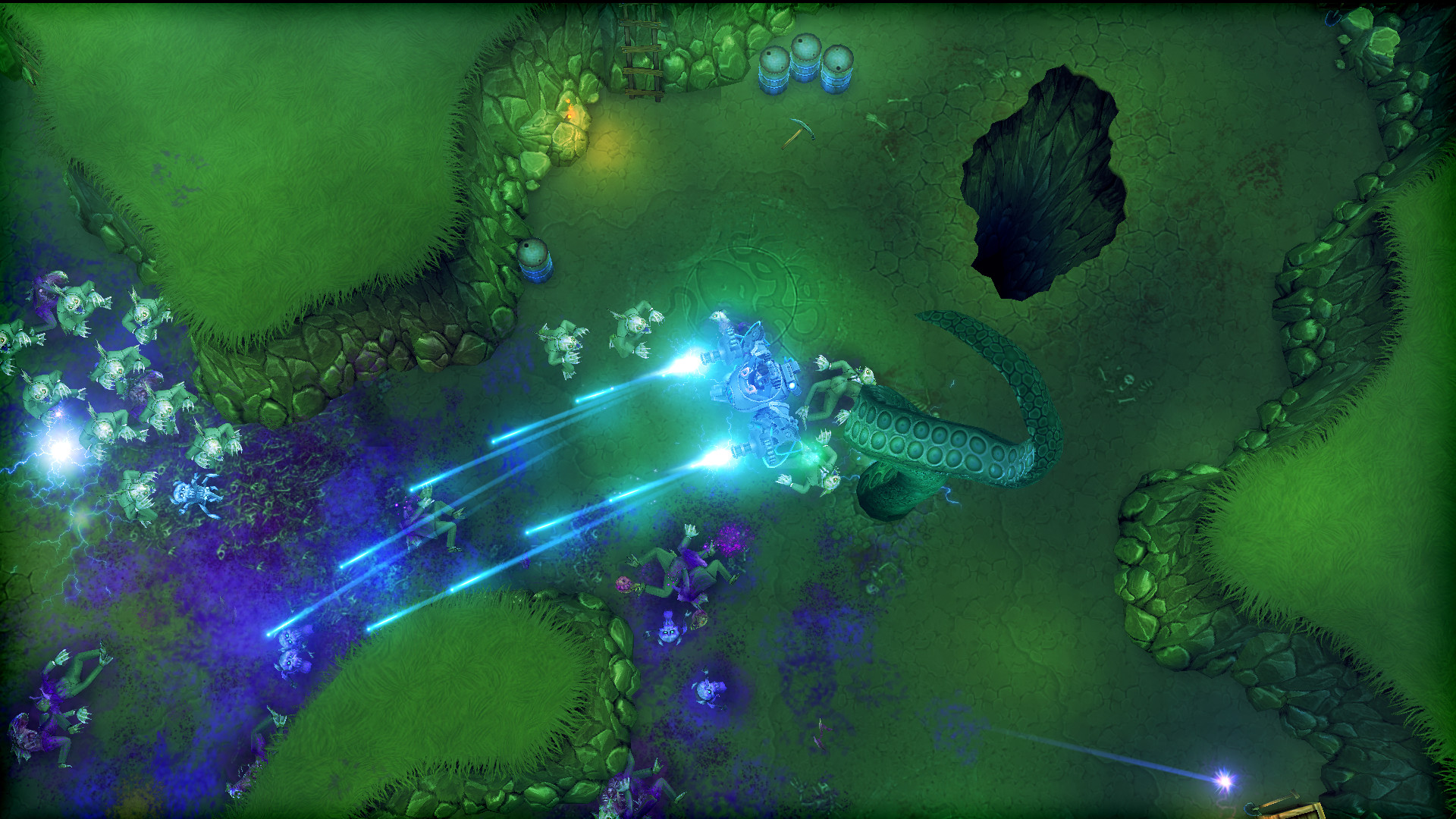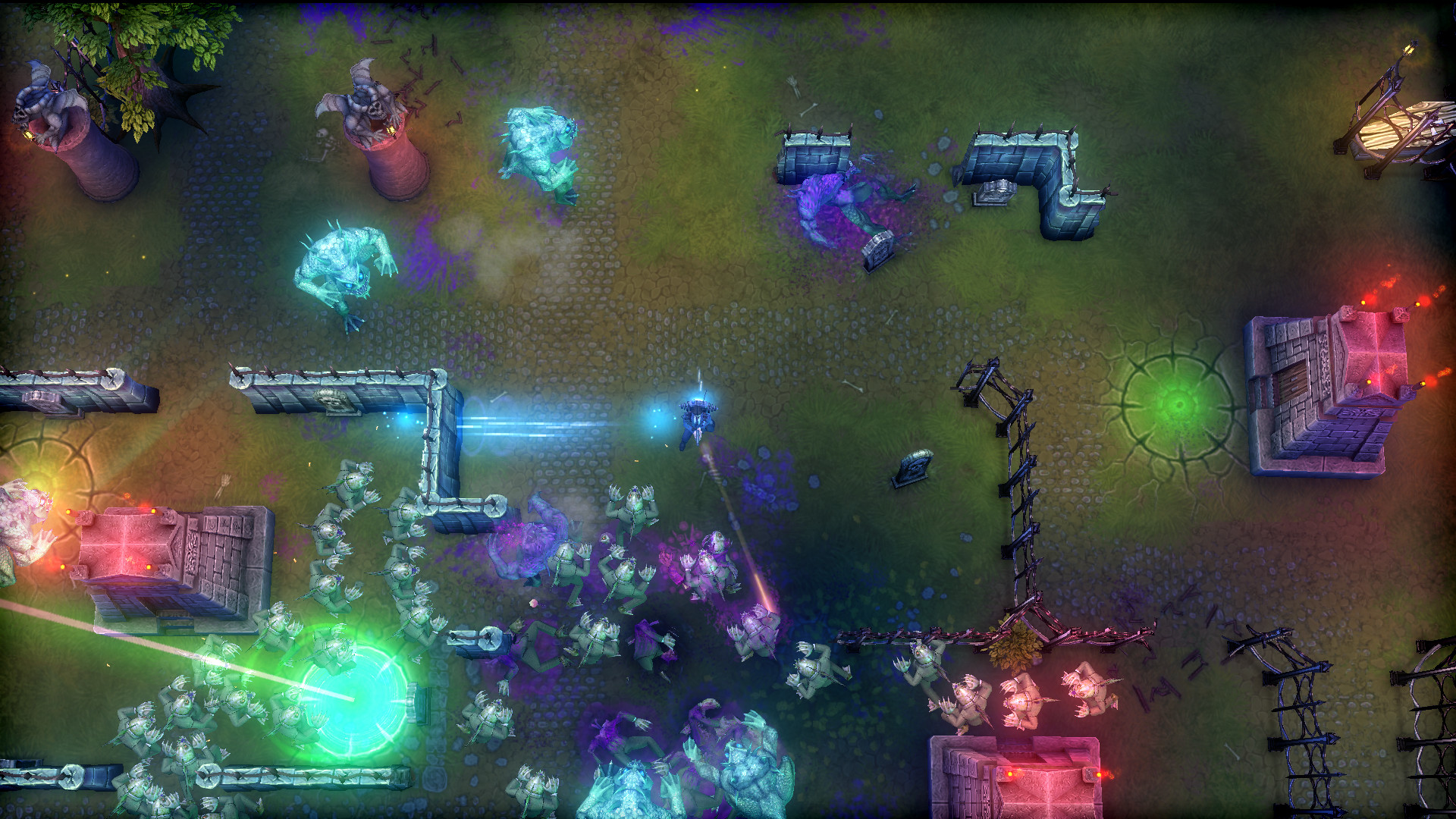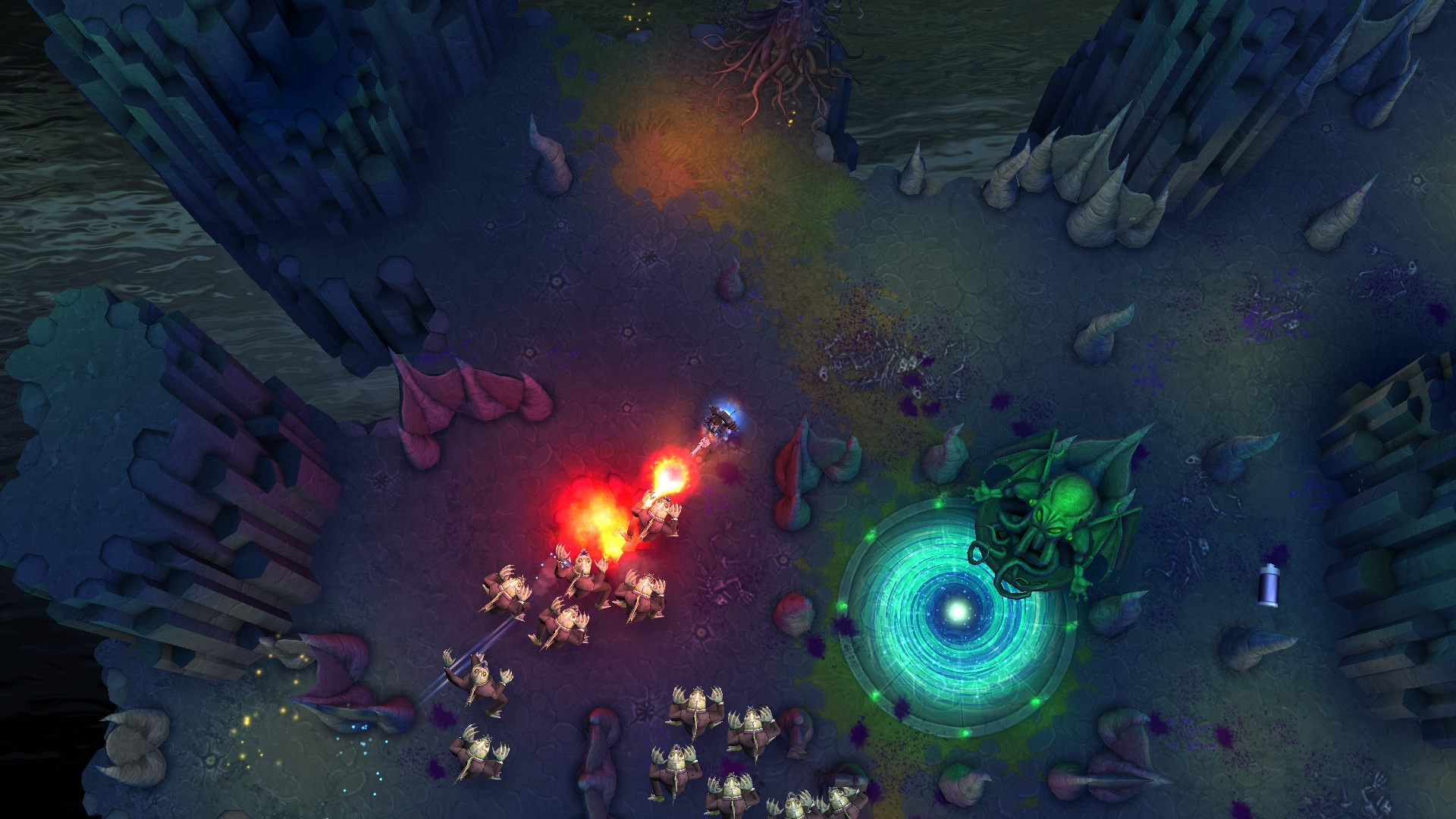The indie developer 10tons Ltd has created dozens of games over the years, but their twin stick shooters are what always gain the most attention. Of these shooters, Neon Chrome and Crimsonland are easily the most well-known. Crimsonland in particular has built up quite the cult following since its initial release in 2003, and subsequent rerelease in 2014. For their latest twin stick shooter, Tesla vs Lovecraft, 10tons has returned to the formula that made them moderately famous in the first place. The result is a game that may be a bit lacking in content compared to their previous titles, but makes up for it with more refined core mechanics.
The game starts out with Lovecraft interrupting Tesla while he is showing off some of his electrical wonders to the general populace. Lovecraft fears Tesla’s technology, and warns that it will upset the natural order. When Tesla fails to heed his warning, Lovecraft uses his arcane tomes to unleash eldritch horrors upon the city of Arkham, destroying Tesla’s lab and stealing some of his technology in the process. How summoning ancient gods is any less dangerous than electricity is never fully explained, but ultimately what little exposition the game provides is merely an excuse to use lighting guns and death rays to wipe out hordes of freaky fish people and flying tumors with teeth.
The game’s main campaign presents you with a map of Arkham that contains a little over 30 levels, each of which can be beaten in about two or three minutes, assuming you don’t die. Missions really don’t have any objective beyond surviving against hundreds of enemies and destroying Cthulhu statues whenever they appear. Much like in most arcade-style shooters, power-ups will randomly drop as you play, and you can increase the frequency of them by killing large groups of enemies at once.

Power-ups come in four types: Weapons, Abilities, Supplies, and Perks. Weapons are fairly self-explanatory. You start each level with a pitifully underpowered pistol that you’ll want to ditch as soon as you can. The game’s arsenal ranges from period weapons like revolvers and Tommy Guns, to the wacky pseudoscience that you’d expect from a game about Tesla. There’s only nine guns in the game, which is a fairly significant reduction from Crimsonland. The weapon types are also fairly limited, with four of those guns being some form of shotgun, and three of them being assault rifle-style automatics. The only two that can’t be described as a shotgun or automatic rifle are the revolver and ball lightning gun, and sadly those are very underwhelming compared to the rest of the choices available to you.
Luckily, your weapons are supplemented with Abilities. These are effectively sub weapons with limited charges, and they are much more varied than the standard weapons. Some examples include stationary Tesla Coil turrets, ethereal disks that ricochet off terrain, a pulse of eldritch fire, and a scattershot of lightning bolts. There’s about a dozen of them in all, and they periodically spawn around the map just like any other power-up. They typically have six charges by default, but there are ways to increase that number.
Supplies are another type of power-up you’ll encounter, and they are just consumables that do something once picked up. The most common of them are health packs, shields that give you invulnerability for a few seconds, and experience doublers. Arguably the most useful of them is the nuke, which does exactly what you imagine it does.
The final type of power-up are the Perks. These function exactly like the perks in Crimsonland, and many of them are even tweaked versions of perks from that game. You fill an experience bar as you kill enemies, and each time you level up you are presented with a choice of two perks. These are passive abilities that give you a small boost. Outside of the bullet ricochet perk, many of them are percentage-based buffs that stack on top of each other. Getting two 20% extra damage perks will give you 40% extra damage total, two extra projectile perks gives you two extra shots per trigger pull, etc. Combining different perks together can have some extremely satisfying results, such as extra projectiles and bullet ricochet with just about any shotgun. There’s some epic perks too, and they are always a significant boost.

Tesla vs Lovecraft plays a lot like Crimsonland, which is why I keep referencing it. It may have a more refined campaign mode and some tweaks here and there, but fans of 10tons’ previous cult hit will feel right at home. Two of the most significant tweaks are the personal teleporter and Tesla Mech. The teleporter comes with three charges that gradually regenerate while not in use, and it allows you to quickly blink out of dire situations that would normally result in your untimely demise. The teleporter makes Tesla vs Lovecraft feel faster and more mobile than other 10tons games, which is a big plus in my opinion.
The Tesla Mech acts like a super mode. Mech parts spawn on the map like any other power-up, and once you’ve collected six of them, you can press the E key to call down your stompy iron companion. Equipped with dual miniguns and a personal teleporter that causes damage to enemies, the Tesla Mech turns all but the toughest enemies into a fine, gory mist. It’s perhaps the most fun part of the entire game, and it lasts just long enough to give you an edge, but not so long that it becomes boring to use.
The game’s campaign is divided into three Planes, each of which have around 31 to 33 missions. The Normal Plane is where you start, and mainly acts as a tutorial to prepare you for Ethereal and Eldritch. During the Normal Plane, every level you complete gives you access to new power-ups. Normal took me about two hours to complete, and outside of a handful of levels, it’s not especially challenging. Ethereal and Eldritch are remixed versions of the same levels, but feature tougher and more numerous enemies.

This is where Tesla vs Lovecraft‘s overarching progression system comes in, called Inventions. These are permanent upgrades that are purchased with Ether Crystals, and most of them have multiple tier levels. These Ether Crystals are collected by killing enemies, completing daily quests, and once you get to the Ethereal Plane, they’ll spawn during levels. Most of the Inventions are quite expensive, and you’ll probably only be able to afford one or two by the time you complete Normal. Inventions include increasing the duration of the Tesla Mech, giving you more teleport charges, higher chance of epic perk drops, etc. They might be fairly minor individually, but really add up after a while. Trust me, you will need all the help you can get by the time you reach Eldritch.
The Ethereal and Eldritch Planes are the source of most of my complaints about Tesla vs Lovecraft, and based on the Steam forums, I’m not alone here. Simply put, the second two planes rely way too much on lucky power-ups to get anywhere. You don’t realize just how pathetic the pistol is until you hit Ethereal and face significantly tougher enemies. You start each level inside your mech, but enemy spawns are fairly sporadic until after you leave it. Then it’s a mad dash to the nearest weapon pick up and a lot of praying that some decent power-ups follow soon after. Even with the teleporter, it can be hard to kite enemies effectively because they tend to spawn all over the place. Many levels are also packed with dead ends and choke points. The Docks in particular get complained about a lot on the forums, even after several patches that tweaked the level.
On the bright side, the developers are very receptive to feedback and have been releasing new patches on a weekly basis since release. One example of this was a patch last week that honestly broke the game for me. They decided that the ability to adjust camera distance made the game too easy and less fun, so they removed it. The problem is that the default camera is pulled in way too close. You have very little time to react to enemy hordes, and you’ll frequently get ambushed by enemies you didn’t see coming. The low FOV personally made me feel physically ill as well. I brought this up in the forums and the developer chatted with me and some other players over it. After just a few days, they reversed this decision and brought back the adjustable camera. These are the signs of a developer that truly cares about their game and audience, and it makes me confident that the issues Tesla vs Lovecraft have will eventually be fixed.

Tesla vs Lovecraft isn’t a massive leap forward in the realm of twin stick shooters, but it is a solid game that succeeds at what it sets out to do. There’s a few underwhelming weapons and abilities, but most of them are fun to use, and the Tesla Mech is a magnificent power fantasy that doesn’t overstay its welcome. In many ways, it’s an improvement over Crimsonland. The introduction of the personal teleporter makes the game feel faster, and it gives you more options in combat. There are actual levels with terrain and scenery in them, and the enemies are far more visually interesting and coherent than Crimsonland‘s random collection of lizard people and spiders.
Besides the harsh difficulty spikes and occasionally poorly designed level in Ethereal and Eldritch, the only other real complaints I have about Tesla vs Lovecraft are the lack of weapon variety and the unpleasant grind that is upgrading your Inventions. With a bit more content and some tweaks here and there, I can see Tesla vs Lovecraft being a twin stick shooter I return to every now and then for a few rounds of the endless survival mode. It’s well worth checking out if you are a fan of the genre, especially if you’ve liked 10tons’ games in the past. You can currently find it on Steam for $14.99.
